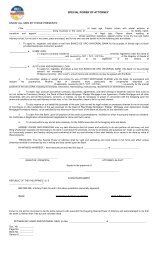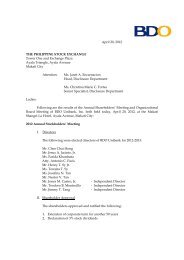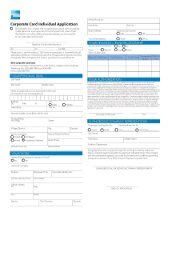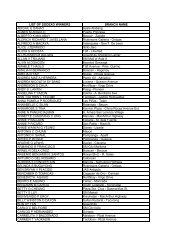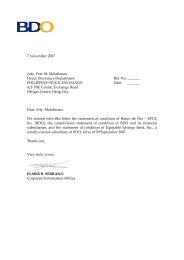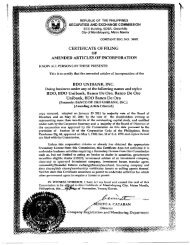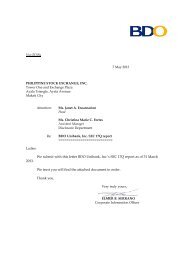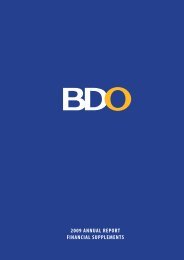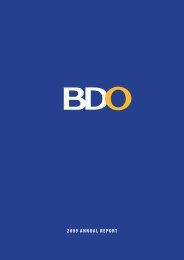Notes to Financial Statements - BDO
Notes to Financial Statements - BDO
Notes to Financial Statements - BDO
Create successful ePaper yourself
Turn your PDF publications into a flip-book with our unique Google optimized e-Paper software.
<strong>Notes</strong> <strong>to</strong> <strong>Financial</strong> <strong>Statements</strong>DECEMBER 31, 2008, 2007 AND 2006(Amounts in Millions Except Per Share Data)The best evidence of the fair value of a derivative at initial recognition is the transaction price (the fair value of the consideration given orreceived) unless the fair value of the instrument is evidenced by comparison with other observable current market transactions in the sameinstrument or based on a valuation technique whose variables include only data from observable markets. When such evidence exists, theGroup recognizes profit or loss at initial recognition.For more complex instruments, the Group uses proprietary models, which usually are developed from recognized valuation models. Someor all of the inputs in<strong>to</strong> these models may not be market observable, and are derived from market prices or rates or are estimated basedon assumptions. When entering in<strong>to</strong> a transaction, the financial instrument is recognized initially at the transaction price, which is the bestindica<strong>to</strong>r of fair value, although the value obtained from the valuation model may differ from the transaction price. This initial difference infair value indicated by valuation techniques is recognized as profit or loss depending upon the individual facts and circumstances of eachtransaction and not later than when the market data becomes observable.The value produced by a model or other valuation technique is adjusted <strong>to</strong> allow for a number of fac<strong>to</strong>rs as appropriate, because valuationtechniques cannot appropriately reflect all fac<strong>to</strong>rs market participants take in<strong>to</strong> account when entering in<strong>to</strong> a transaction. Valuation adjustmentsare recorded <strong>to</strong> allow for model risks, bid-ask spreads, liquidity risks as well as other fac<strong>to</strong>rs. Management believes that these valuationadjustments are necessary and appropriate <strong>to</strong> fairly state financial instruments carried at fair value on the statement of condition.Certain derivatives embedded in other financial instruments are considered as separate derivatives when their economic characteristicsand risks are not closely-related <strong>to</strong> those of the host contract and the host contract is not carried at fair value through profit or loss. Theseembedded derivatives are bifurcated from the host contracts and are measured at fair value with changes in fair value recognized in theincome statement (except for the embedded derivatives in CLNs linked <strong>to</strong> ROP bonds which were not bifurcated from the host contracts aspermitted for prudential reporting and were reclassified <strong>to</strong> loans).Certain derivatives may be designated as either: (i) hedges of the fair value of recognized assets or liabilities or firm commitments (fair valuehedge); or, (ii) hedges of highly probable future cash flows attributable <strong>to</strong> a recognized asset or liability, or a forecasted transaction (cash flowhedge). Changes in the fair value of derivatives are recognized in profit or loss. The method of recognizing the resulting fair value gain or losson derivatives that qualify as hedging instrument depends on the hedging relationship designated by the Group.2.7 Non-current Assets Held-for-SaleAssets held-for-sale include real and other properties acquired through repossession or foreclosure that the Group intends <strong>to</strong> sell within oneyear from the date of classification as held for sale.Assets classified as held for sale are measured at the lower of their carrying amounts immediately prior <strong>to</strong> their classification as held for saleand their fair value less costs <strong>to</strong> sell. Assets classified as held for sale are not subject <strong>to</strong> depreciation or amortization. The profit or loss arisingfrom the sale of held-for-sale assets is included as part of Income from Assets Acquired under Other Operating Income account in the incomestatement.2.8 Investment PropertiesInvestment properties are stated at cost. The cost of an investment property comprises its purchase price and directly attributable costincurred. This also includes land and building acquired by the Group from defaulting borrowers not held for sale in the next 12 months. Forthese assets, the cost is recognized initially at fair value. Investment properties except land are depreciated on a straight line basis over aperiod of 10 years.Subsequent <strong>to</strong> initial recognition, investment property is stated at cost less accumulated depreciation and any impairment losses.The Group adopted the cost model in measuring its investment property, hence, is carried at cost less accumulated depreciation andany impairment in value. Depreciation and impairment loss are recognized in the same manner as in Premises, Furniture, Fixtures andEquipment.Investment property is derecognized upon disposal or when permanently withdrawn from use and no future economic benefit is expectedfrom its disposal. Any gain or loss on the retirement or disposal of an investment property is recognized in the income statement in the yearof retirement or disposal.2.9 Equity InvestmentsIn the Group financial statements, investments in associates are accounted for under the equity method of accounting and are initiallyrecognized at cost, less any impairment losses (see Note 2.21).The Group’s share of its associates’ post-acquisition profits or losses is recognized in the income statement, and its share of post-acquisitionmovements in reserves is recognized in reserves. The cumulative post-acquisition movements are adjusted against the carrying amount of theinvestment. When the Group’s share of losses in an associate equals or exceeds its interest in the associate, including any other unsecuredreceivables, the Group does not recognize further losses, unless it has incurred obligations or made payments on behalf of the associate.Unrealized gains on transactions between the Group and its associates are eliminated <strong>to</strong> the extent of the Group’s interest in the associates.Unrealized losses are also eliminated unless the transaction provides evidence of an impairment of the asset transferred. Accounting policieshave been changed where necessary <strong>to</strong> ensure consistency with the policies adopted by the Group.Thinking Ahead To Get You Ahead • Annual Report 2008 15



